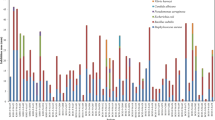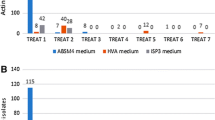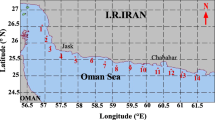Abstract
Among the 116 actinomycetes collected from marine sediments of the Yellow Sea, 56 grew slowly and appeared after 2–3 weeks of incubation. Among the 56 strains, only 3 required seawater (SW) for growth, and 21 grew well in the medium prepared with SW rather than distilled water (DW), while the remaining 32 grew well either with SW or with DW. Six representatives with different morphological characteristics, including 1 SW-requiring strain and 5 well-growing with SW strains, were selected for phylogenetic analysis based on 16S rRNA gene. Two strains belong to Micrococcaceae and Nocardiopsaceae respectively. The other 4 strains belong to the family of Streptomycetaceae. In the analyzed 6 strains, one was related to Nocardiopsis spp. and the other three were related to Streptomyces spp., representing new taxa. Bioactivity testing of fermentation products from 3 SW-requiring strains and 21 well-growing with SW strains revealed that 17 strains possessed remarkable activities against gram-positive pathogen or/and tumor cells, suggesting that they were prolific resources for natural drug discovery.
Similar content being viewed by others
References
Asolkar, R. N., Jensen, P. R., Kauffman, C. A., and Fenical, W., 2006. Daryamides A-C, weakly cytotoxic polyketides from a marine-derived actinomycete of the genus Streptomyces strain CNQ-085. Journal of Natural Products, 69(12): 1756–1759.
Bugni, T. S., Woolery, M., Kauffman, C. A., Jensen, P. R., and Fenical, W., 2006. Bohemamines from a marine-derived Streptomyces sp. Journal of Natural Products, 69(11): 1626–1628.
Bull, A. T., Ward, A. C., and Goodfellow, M., 2000. Search and discovery strategies for biotechnology: The paradigm shift. Microbiology and Molecular Biology Reviews, 64(3): 573–606.
Chenna, R., Sugawara, H., Koike, T., Lopez, R., Gibson, T. J., Higgins, D. G., and Thompson, J. D., 2003. Multiple sequence alignment with the Clustal series of programs. Nucleic Acids Research, 31(13): 3497–3500.
Cho, J. Y., Kwon, H. C., Williams, P. G., Kauffman, C. A., Jensen, P. R., and Fenical, W., 2006. Actinofuranones A and B, polyketides from a marine-derived bacterium related to the genus Streptomyces (actinomycetales). Journal of Natural Products, 69(3): 425–428.
Chun, J., and Goodfellow, M., 1995. A phylogenetic analysis of the genus Nocardia with 16S rRNA gene sequences. International Journal of Systematic Bacteriology, 45(2): 240–245.
Das, S., Lyla, P. S., and Khan, S. A., 2006. Marine microbial diversity and ecology: importance and future perspectives. Current Science, 90(10): 1325–1335.
Edwards, U., Rogall, T., Blocker, H., Emde, M., and Bottger, E. C., 1989. Isolation and direct complete nucleotide determination of entire genes. Characterization of a gene coding for 16S ribosomal RNA. Nucleic Acids Research, 17(19): 7843–7853.
Ellaiah, P., Kalyan, D., Rao, V. S., and Rao, B. V., 1996. Isola tion and characterisation of bioactive actinomycetes from marine sediments. Hindustan Antibiotics Bulletin, 38(1–4): 48–52.
Gontang, E. A., Fenical, W., and Jensen, P. R., 2007. Phylogenetic diversity of gram-positive bacteria cultured from marine sediments. Applied and Environmental Microbiology, 73(10): 3272–3282.
Hughes, J. B., Hellmann, J. J., Ricketts, T. H., and Bohannan, B. J., 2001. Counting the uncountable: statistical approaches to estimating microbial diversity. Applied and Environmental Microbiology, 67(10): 4399–4406.
Jensen, P. R., Gontang, E., Mafnas, C., Mincer, T. J., and Fenical, W., 2005. Culturable marine actinomycete diversity from tropical Pacific Ocean sediments. Environmental Microbiology, 7(7): 1039–1048.
Kimura, M., 1980. A simple method for estimating evolutionary rates of base substitutions through comparative studies of nucleotide sequences. Journal of Molecular Evolution, 16(2): 111–120.
Kumar, S., Tamura, K., and Nei, M., 2004. MEGA3: integrated software for molecular evolutionary genetics analysis and sequence alignment. Briefings in Bioinformatics, 5(2): 150–163.
Magarvey, N. A., Keller, J. M., Bernan, V., Dworkin, M., and Sherman, D. H., 2004. Isolation and characterization of novel marine-derived actinomycete taxa rich in bioactive metabolites. Applied and Environmental Microbiology, 70(12): 7520–7529.
Mearns-Spragg, A., Bregu, M., Boyd, K. G., and Burgess, J. G., 1998. Cross-species induction and enhancement of antimicrobial activity produced by epibiotic bacteria from marine algae and invertebrates, after exposure to terrestrial bacteria. Letters in Applied Microbiology, 27(3): 142–146.
Mincer, T. J., Jensen, P. R., Kauffman, C. A., and Fenical, W., 2002. Widespread and persistent populations of a major new marine actinomycete taxon in ocean sediments. Applied and Environmental Microbiology, 68(10): 5005–5011.
Moore, B. S., Kalaitzis, J. A., and Xiang, L., 2005. Exploiting marine actinomycete biosynthetic pathways for drug discovery. Antonie Van Leeuwenhoek, 87(1): 49–57.
Morales-Rodriguez, I., Yanez-Morales Mde, J., Silva-Rojas, H. V., Garcia-de-Los-Santos, G., and Guzman-de-Pena, D. A., 2007. Biodiversity of Fusarium species in Mexico associated with ear rot in maize, and their identification using a phylogenetic approach. Mycopathologia, 163(1): 31–39.
Mosmann, T., 1983. Rapid colorimetric assay for cellular growth and survival: application to proliferation and cytotoxicity assays. Journal of Immunological Methods, 65(1–2): 55–63.
Newman, D. J., and Cragg, G. M., 2004. Marine natural products and related compounds in clinical and advanced preclinical trials. Journal of Natural Products, 67(8): 1216–1238.
Pathom-Aree, W., Stach, J. E., Ward, A. C., Horikoshi, K., Bull, A. T., and Goodfellow, M., 2006. Diversity of actinomycetes isolated from Challenger Deep sediment (10 898 m) from the Mariana Trench. Extremophiles, 10(3): 181–189.
Ravenschlag, K., Sahm, K., Pernthaler, J., and Amann, R., 1999. High bacterial diversity in permanently cold marine sediments. Applied and Environmental Microbiology, 65(9): 3982–3989.
Ren, H., Gu, Q. Q., Cui, C. B., and Zhu, W. M., 2006. The cytotoxic constituents from marine-derived streptomyces 3320#. Journal of Ocean University of China, 5(1): 75–81.
Stach, J. E., Maldonado, L. A., Masson, D. G., Ward, A. C., Goodfellow, M., and Bull, A. T., 2003. Statistical approaches for estimating actinobacterial diversity in marine sediments. Applied and Environmental Microbiology, 69(10): 6189–6200.
Stackebrandt, E., Rainey, F. A., and Ward-Rainey, N. L., 1997. Proposal for a new hierarchic classification system, Actinobacteria classis nov. International Journal of Systematic and Evolutionary Microbiology, 47(2): 479.
Weisburg, W. G., Barns, S. M., Pelletier, D. A., and Lane, D. J., 1991. 16S ribosomal DNA amplification for phylogenetic study. Journal of Bacteriology, 173(2): 697–703.
Williams, P. G., Asolkar, R. N., Kondratyuk, T., Pezzuto, J. M., Jensen, P. R., and Fenical, W., 2007a. Saliniketals A and B, bicyclic polyketides from the marine actinomycete Salinispora arenicola. Journal of Natural Products, 70(1): 83–88.
Williams, P. G., Buchanan, G. O., Feling, R. H., Kauffman, C. A., Jensen, P. R., and Fenical, W., 2005. New cytotoxic salinosporamides from the marine Actinomycete Salinispora tropica. Journal of Organic Chemistry, 70(16): 6196–6203.
Williams, P. G., Miller, E. D., Asolkar, R. N., Jensen, P. R., and Fenical, W., 2007b. Arenicolides A-C, 26-membered ring macrolides from the marine actinomycete Salinispora arenicola. Journal of Organic Chemistry, 72(14): 5025–5034.
Author information
Authors and Affiliations
Corresponding author
Rights and permissions
About this article
Cite this article
Zhang, S., Ye, L. & Tang, X. Diversity and bioactivity of actinomycetes from marine sediments of the Yellow Sea. J. Ocean Univ. China 11, 59–64 (2012). https://doi.org/10.1007/s11802-012-1858-1
Received:
Revised:
Accepted:
Published:
Issue Date:
DOI: https://doi.org/10.1007/s11802-012-1858-1




